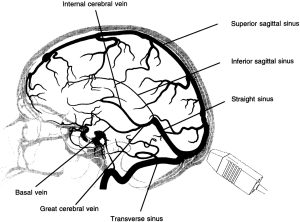 The great cerebral vein ( vein of Galen) is one of the large blood vessels in the skull draining the cerebrum of the brain.
The great cerebral vein ( vein of Galen) is one of the large blood vessels in the skull draining the cerebrum of the brain.
The great cerebral vein is one of the deep cerebral veins.
Length of great cerebral vein of Galen varies from 0.15 to 4.2 cm.
The veins at the anterior poles of the thalami merge posterior to the pineal gland to form the great cerebral vein.
Most of the blood in the deep cerebral veins collects into the great cerebral vein.
There are two types of veins in the brain: The superficial veins at the dorsal parts of the hemispheres run upward and medially and empty into the large superior sagittal sinus in the upper margin of the falx cerebri.
The superior sagittal sinus divides into two parts called the transverse sinuses where the falx cerebri meets the tentorium cerebelli.
The sigmoid sinus, which continues the transverse sinus, empties into the jugular vein at the jugular foramen.
The internal jugular vein leaves the skull and travels downward to the neck.
The veins of the brain have very thin walls and contain no valves.
They emerge in the brain and lie in the subarachnoid space.
They pierce the arachnoid matter and the meningeal layer in the dura and drain into the cranial venous sinuses.
Most conditions associated with the great cerebral vein are due to congenital defects.
Vein of Galen aneurysmal malformations (VGAM) are the most common form of symptomatic cerebrovascular malformation in neonates and infants.
Absence of the great cerebral vein is a congenital disorder.
The deep cerebral veins of the brain normally drain through the great cerebral vein. In its absence, most patients die in the neonatal period or in early infancy.
Thrombosis of the great cerebral vein is a form of stroke due to a blood clot in the vein.
Thrombosis of the great cerebral vein affects just 3 to 8% of patients, predominantly women.
Symptom presentation of thrombosis of the great cerebral vein includes:
consciousness problems, headaches, nausea, visual defects, fatigue, disturbance of eye movements and pupillary reflexes, or coma.
Risk factors include oral contraceptives, pregnancy, and postpartum period.
